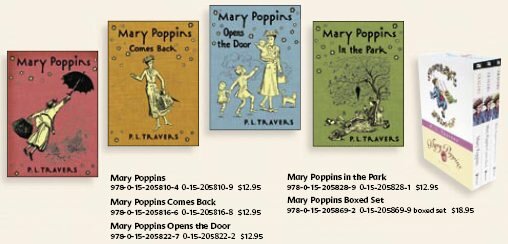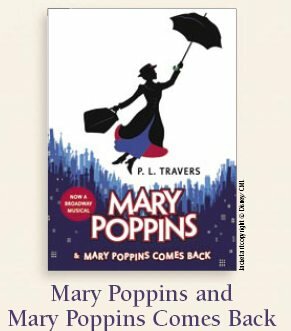
Cover | Archive | Crime | Fantasy/SF | Popular | Historical | Comics | Non-Fiction | Children's |
Table of Contents Mary Poppins
Reviews
Feature Articles
Enid Blyton's Magic Faraway Tree/span>
Harcourt Children's Books - Special Supplement
Elizabeth Chayne's Reading Room
Stories and Serials
Phyllis Owen: A Soft White Cloud Chapter Three
Paul Norman: Heraklion ~ Outcast
Mary Poppins
From Wikipedia, the free encyclopedia (See also the Harcourt Children's Books supplement - menu left)
Books
Mary Poppins, published 1934
The first book introduces the Banks family, consisting of Mr. Banks and Mrs. Banks and their children Jane, Michael, and baby twins John and Barbara. When the children's nanny Katie Nana storms out in a huff, Mary Poppins arrives at their home, complete with her travelling carpetbag, blown by a very strong wind. She accepts the job and the children soon learn that their nanny, though she is stern, vain and almost always cross, has a magical touch that makes her wonderful. Among the things Jane and Michael experience are a tea party on a ceiling with Mr. Wiggs, travelling around the world with a compass, buying gingerbread stars from the extremely old Mrs. Corry, a birthday party at the zoo among the animals, and Christmas shopping with a star.
Original and Revised Versions of the Bad Tuesday Chapter
The original 1945 printing of Mary Poppins contained a version of the chapter Bad Tuesday in which Mary and the children use a compass to visit places all over the world in a remarkably short period of time. Because it contained a variety of cultural and racial stereotypes of the Chinese, Eskimos, Africans, and Native Americans, Travers responded to criticism by revising the chapter i 1981 to include animal representatives instead of people. At the same time, original illustrator Mary Shepard altered the accompanying drawing of the compass to show a Polar Bear at the north, a Macaw at the south, a Panda at the east, and a Dolphin at the west.
Mary Poppins Comes Back, published 1935
Nothing has been right since Mary Poppins left Number Seventeen Cherry Tree Lane. One day when Mrs. Banks sends the children out to the park, Michael flies his kite up into the clouds. Everyone is surprised when it comes down bringing Mary Poppins as a passenger, who returns to the Banks home and takes charge of the children once again. This time Jane and Michael meet the fearsome Ms. Andrew, experience an upside-down tea and visit a circus in the sky. There is also a new addition to the Banks family with little Annabel.
Mary Poppins Opens the Door, published 1943
Main article: Mary Poppins Opens the Door
When Mary last left the Banks children in Cherry Tree Lane, she took a "return ticket, just in case". In the third book she returns to the park in front of Cherry Tree Lane the way she came, falling with fireworks. Once again she takes up nanny duties in the Banks household and leads Jane, Michael, John and Barbara on various adventures. This time they visit her uncle Mr. Twigley, befriend a statue who has come to life, go riding on peppermint horses and experience a garden party under the sea.
Mary Poppins in the Park, published 1952
This fourth book contains six adventures of the Banks children with Mary Poppins during their outings into the park along Cherry Tree Lane. Chronologically the events in this book occurred during the second or third book (Mary Poppins Comes Back and Mary Poppins Opens the Door respectively). Among the adventures they experience are a tea party with the people who live under the dandelions, a visit to cats on a different planet and a Halloween dance party with their shadows.
Mary Poppins From A to Z, published 1962
Twenty-six vignettes - one for each letter of the alphabet - weave unexpected tales of Mary Poppins, the Banks children, and other characters from Travers's previous novels. Each vignette is filled with fun and unusual words that start with the featured letter.
Mary Poppins in the Kitchen, published 1975
Mary Poppins comes to the rescue when the Banks' family cook has to go on an unexpected leave, teaching the young Banks children the basics of cooking in the process. The book includes recipes.
Mary Poppins in Cherry Tree Lane, published 1982
Mary Poppins takes the Banks children on yet another memorable adventure, this time on the magical Midsummer's Eve. All kinds of strange things can happen, and even mythical figures can descend from the heavens. At the back of the book is a list of the herbs that are mentioned in the story, with their botanical, local and Latin names.
Mary Poppins and the House Next Door, published 1988
Cherry Tree Lane neighbors are distressed to learn that their beloved Number Eighteen, an empty house for which each has created an imaginary, wished-for tenant, is about to be occupied by Mr. Banks' childhood governess, Miss Andrew--otherwise known as the Holy Terror. Her dreaded arrival brings a pleasant surprise as well, for Luti, a boy from the South Seas, has accompanied her as both servant and student. Delighted by the prospect of a new friend, Jane and Michael are frustrated by the restrictions which the hypochondriacal Miss Andrew has placed on Luti, who grows more and more homesick for his family and tropical surroundings. When the call in his heart to return home becomes more than he can bear, it is Mary Poppins who makes the trip possible by means of a visit to the Man in the Moon.
Adaptations
1964 film
Main article: Mary Poppins (film)
Mary Poppins was made into a film by Walt Disney Productions in 1964 based on the series of children's books. According to the 40th anniversary DVD release of the film in 2004, Walt Disney first attempted to purchase the film rights to Mary Poppins from P.L. Travers as early as 1938 but was rebuffed because Travers did not believe a film version of her books would do justice to her creation and did not want an animated cartoon based on it. He finally succeeded in 1961, although Travers demanded and got script approval rights.
The relationship between Travers and Disney is detailed in Mary Poppins She Wrote, a biography of Travers, by Valerie Lawson, published by Aurum Press in the United Kingdom. The biography is the basis for two documentaries on Travers, The Real Mary Poppins and The Shadow of Mary Poppins.
The process of planning the film and composing the songs took about two years. Songs in the film are by the Sherman Brothers. Mary Poppins is played by Julie Andrews. Disney cast Dick Van Dyke in the key supporting role of Bert. The Banks children were played by Karen Dotrice and Matthew Garber. Mr and Mrs Banks were played by David Tomlinson and Glynis Johns respectively. The film is rated G by the MPAA.
Musical
Main article: Mary Poppins (musical)
In December 2004, Mary Poppins: The Musical opened at the Prince Edward Theatre, London, after previewing in Bristol. It received critical acclaim and was nominated for nine 2005 Olivier Awards. It won two awards, Best Actress in a Musical, for Laura Michelle Kelly, and Best Theatre Choreography, for Matthew Bourne and Stephen Mear.
The musical has original music and lyrics by Richard M. Sherman and Robert B. Sherman, book by Julian Fellowes, and a few new songs and additional music and lyrics by George Stiles and Anthony Drewe.
In November 2006 a subsequent company of "Mary Poppins: The New Musical� opened at the New Amsterdam Theatre, New York. It received excellent notices and was nominated for 7 TONY Awards. It won one award, Best Scenic Design of a Musical, for Bob Crowley.
Main characters
Mary Poppins
Main article: Mary Poppins (character)
Mary Poppins is the main character of the books, a magical nanny who sweeps into the Banks home of Cherry Tree Lane and takes charge of the four Banks children. She never openly acknowledges her strange and magical powers, and feigns insult when one of the children refers to her previous adventures.
Mrs. Banks
Mrs. Winifred Banks is the wife of George Banks and mother of Jane and Michael. In the books she is the struggling mistress of the Banks household. In the film she is a valiant and fervent suffragette and feminist. In the stage musical she is a former actress who is under constant pressure from her husband as she struggles to enter her his social circle.
Mr. Banks
George Banks is Mary Poppins' employer. He works at the Bank in the City of London, and lives at 17 Cherry Tree Lane with his wife and their children. In the books he is rarely present but is gruffly loving of his wife and children. In the film he has a more prominent role as a cross man who wants order and largely ignores his children but later on his attitude changes. His role in the stage musical is similar to the film, but he has an additional backstory in which he was tormented by a cruel nanny during his childhood.
The Banks' children
In the books there are five Banks children: Jane, Michael, John, Barbara and Annabel. Jane and Michael are the eldest and go on most of the magical adventures with Mary Poppins. John and Barbara are toddler twins who only start going on adventures in the second book. Annabel is the youngest and joins the family midway through the second book. Only Jane and Michael appear in the film and stage musical.
Bert
Bert is one of Mary Poppins' many friends. He normally draws pictures on the sidewalk with chalk (a so-called screever), but when it rains he instead sells matches and is thusly known as the Matchman. Mary sometimes goes on outings with Bert on her Second Tuesday off. In the film Bert is a combination of the Matchman and the Sweep, and has a more prominent role in the children's adventures. In the stage musical he acts as a narrator and close friend of Mary and the Banks children.
Miss Lark
Miss Lark lives next door to Number Seventeen Cherry Tree Lane. She is the owner of two dogs: Andrew and Willoughby. Originally she only had Andrew, who is a purebred, but the mongrel Willoughby joined the family at Andrew's request. She constantly appears throughout the books and is usually appalled by the magical antics of Mary Poppins. She appears in the film and stage musical as a minor role.
Admiral Boom
Admiral Boom also lives along Cherry Tree Lane. He is a former Naval Officer but now lives in a house shaped like a ship with his wife Mrs. Boom and his assistant Binnacle, who is a former pirate. Admiral Boom often appears in the Banks children's adventures, but he is never fazed by the unusual happenings that surround Mary Poppins. In the film he is a neighbour of the Banks family who fires his cannon to mark the time. In the stage musical he only appears as a minor role.
Gateway is published by Paul Edmund Norman on the first day of each month. Hosting is by Flying Porcupine at www.flyingporcupine.com - and web design by Gateway. Submitting to Gateway: Basically, all you need do is e-mail it along and I'll consider it - it can be any length, if it's very long I'll serialise it, if it's medium-length I'll put it in as a novella, if it's a short story or a feature article it will go in as it comes. Payment is zero, I'm afraid, as I don't make any money from Gateway, I do it all for fun! For Advertising rates in Gateway please contact me at Should you be kind enough to want to send me books to review, please contact me by e-mail and I will gladly forward you my home address. Meanwhile, here's how to contact me:

